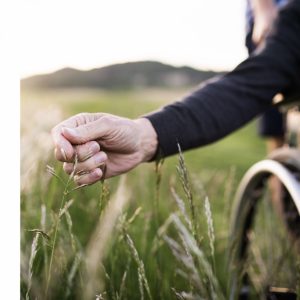CHRT explores the individual and environmental factors linked to healthy aging for people with long-term disabilities
Since 2018, CHRT has worked closely with one of the National Institute on Disability, Independent Living, and  Rehabilitation Research (NIDLRR) rehabilitation research and training centers (RRTC). The project, Investigating Disability factors and promoting Environmental Access for Healthy Living (IDEAL), aims to promote healthy aging for people with long-term physical disabilities.
Rehabilitation Research (NIDLRR) rehabilitation research and training centers (RRTC). The project, Investigating Disability factors and promoting Environmental Access for Healthy Living (IDEAL), aims to promote healthy aging for people with long-term physical disabilities.
What we’ve done
For the IDEAL RRTC, housed within the University of Michigan’s Center for Disability Health and Wellness, CHRT has produced multiple articles and policy briefs that elevate challenges and solutions for individuals aging with long-term disabilities.
In a brief titled Housing crisis is magnified for people with physical disabilities. Here’s how we can help, CHRT describes how individuals with physical disabilities are impacted by the U.S. housing crisis and shares ways to make housing more accessible and affordable.
In another brief titled Telehealth for people with disabilities, CHRT recommends national and state policies to make telehealth more accessible, functional, and supportive for people with disabilities, such as incorporating closed captioning during appointments.
In a third brief, CHRT investigates policy and programmatic solutions for supporting family caregivers, and in a fourth, CHRT explores the additional stress COVID-19 has caused for unpaid caregivers, and why that matters.
And in a 2021 issue of the Annals of Family Medicine, CHRT staff Robyn Rontal, Jaque King, and IDEAL RRTC colleagues describe annual wellness visit (AWV) use among persons with physical disabilities from 2008 to 2016–before, during, and after the rollout of the ACA.
The Annals article, Annual wellness visits for persons with physical disabilities before and after ACA implementation, reports that while the rate of annual wellness visit use was decreasing before the inception of the ACA, that trend reversed when the ACA rolled out and the use of AWVs among persons with disabilities has continued to increase.
The analysis, however, also found stark differences in AWV use based on gender, race, and other factors.
In 2016, for example, commercially insured women with congenital disabilities had the highest rates of AWV use at almost 50 percent. However, Black and Hispanic men with congenital disabilities (commercially insured or Medicare Advantage members) had AWV utilization rates around half that. In addition, people with disabilities were 15 percent less likely overall to use annual wellness visits.
Recent accomplishments
More recently, CHRT fielded a national survey of disability and aging services organizations and shared findings in a webinar titled, Serving those aging with a long-term physical disability during the COVID-19 pandemic: Challenges, successes, and innovations.
Among the 138 organizations surveyed, close to half (48 percent) changed or cut services during the pandemic, and 85 percent reported that the success of their programs was challenged by financial constraints.
“Organizations play an important role to ensure people with disabilities can age successfully,” says Marissa Rurka. “It’s important to uplift their strategies and share what they did during COVID-19 and how they adapted to unprecedented times.”
During the webinar, Riba and Rurka facilitated a panel of representatives from four organizations. The Arc Detroit in Michigan, the Ability Center in Ohio, The League in Indiana, and the Thompson Senior Center in Vermont each discussed challenges that their organizations faced as a result of the pandemic.
Panelists discussed how they adapted to those challenges. They also shared opportunities to better serve those aging with physical disabilities.
In April 2023, findings from this survey were published in the peer-reviewed journal, Disabilities, in a special issue of the journal titled: Aging with disabilities.
The article, Organizations’ Perspectives on Successful Aging with Long-Term Physical Disability, describes the researchers’ methodology and results. Authors define successful aging for this population and which strategies and programs work well.
What we plan to do
CHRT policy staff are now conducting an analysis of dually-eligible (Medicare and Medicaid) members with a physical disability and tracking their utilization of annual wellness visits from 2007-2016.
“We will compare members from a sample of Medicaid expansion states to a sample of states that did not expand Medicaid in order to test the impact of Medicaid expansion,” says Jaque King, associate director of health policy at CHRT.
The team will look at other measures too, such as hospital admissions and emergency department visits pre and post-Medicaid expansion, to test the impact of Medicaid expansion.
Beyond this project, CHRT has also begun working with UM’s Center for Disability Health and Wellness, led by Michelle Meade, an associate professor in the University of Michigan Department of Physical Medicine and Rehabilitation, to launch an RRTC Equity Center.
The new equity center will foster collaboration between organizations and investigators. Participating investigators hail from organizations dedicated to enhancing the health and functioning of individuals with disabilities–particularly those from marginalized and underserved communities.
Collaborating organizations and researchers will analyze existing data, and will develop and evaluate new interventions to change the behaviors of health care providers and systems. CHRT will help center participants learn how to share their findings through policy engagement and advocacy.
###
The project is funded through a grant from the National Institute on Disability, Independent Living, and Rehabilitation Research (NIDILRR grant number 90RTHF0001). NIDILRR is a Center within the Administration for Community Living (ACL), Department of Health and Human Services (HHS).
CHRT’s Interim Executive Director Robyn Rontal is one of the co-PIs.